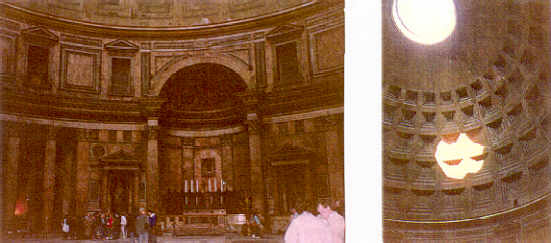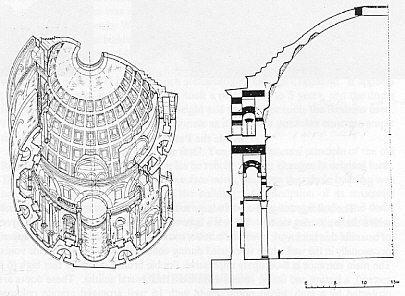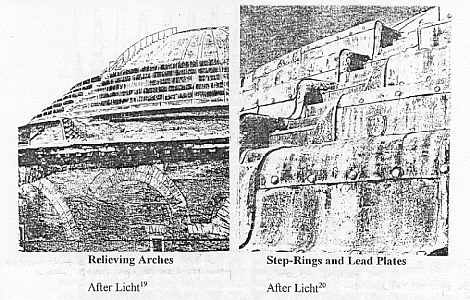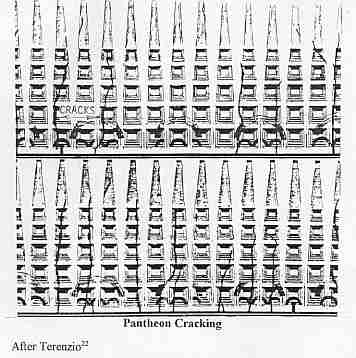ROMANCONCRETE · COMHome · Roman Concrete · The Pantheon The PantheonBy David Moore, P.E., 1995
Unrecognized, the design of this ancient concrete building reveals unparalleled features not encountered in modern design standards. Recent studies reveal several major cracks in the dome, but it still functions unimpaired. This condition will surely excite the curiosity of our structural engineers. The building was built entirely without steel reinforcing rods to resist tensile cracking, so necessary in concrete members, and for this concrete dome with a long span to last centuries is incredible. Today, no engineer would dare build this structure without steel rods! Modern codes of engineering practice would not permit such mischief. No investor with knowledge of concrete design would provide the funding. Additional constraints when attempting to build a structure as large as the Pantheon will be discussed later, but briefly they include the use of inadequate hand tools and unsafe lifting devices. I believe we can learn from this activity. Workers can build from a plan and can successfully use their proven practices only if construction quality controls are maintained. History tells us that the Pantheon is a Greek word meaning to honor all Gods (particularly the Olympian divinities). It is ironic that our building has existed throughout many wars while being dedicated to all Gods; one can readily perceive this to be a temple for our one God. And, the Church has claimed this holy structure as a resting place for its most famous Popes, so we continue to honor its magnificent divinity. The first incarnation of this ancient temple was built by Agrippa, the son-in-law of the Roman Emperor Augustus, about 27 B.C. Today, above the entrance carved in stone are the words "M. AGRIPPA L. F. COS. TERTIUM FECIT" which is translated, "Marcus Agrippa, son of Lucius, in his third consulate, made it." Indeed, it is worth mentioning that Agrippa's engineering talents were used in building the famous Pont de Gard aqueduct in France. As with many cities, tragedy in the form of large firessuch as those of 60, 64, 79, 100 and 110 A.D.seemed to strike Rome. Originally, many Roman buildings contained travertine (limestone rock) which easily cracked in fires. The first Pantheon was severely damaged and required replacement except for some parts of the lower porch section and foundation. The Pantheon was rebuilt by the Emperor Hadrian during the period 118 to 128 A.D. (a time given by Ward-Perkins).2 But the Ward-Perkins's period is disputed by, Lugli who said the building was started sometime after 123 A.D. and was finished by Emperor Pius about 140 A.D.3 However, most of the bricks were made and placed in the Pantheon in 123 A.D., a date that the maker stamped on his bricks. This was discovered in 1892 by the French archaeologist, George Chedanne. It appears the construction of the rotunda walls took a period of 4 to 5 years, and the dome required a like period because of its height and the meager tools the Romans used. This long construction period was fortunate as it gave this pozzolan concrete ample time to cure and gain strength. Was the second temple like the first? Yes, the fundamental principle of the old Roman religion required that the temples be rebuilt without changes in original form. Tradition required that the main entrance face north, and thus the whole building was oriented on the north-south axis of the building. A description of its structural features is separated into the configuration, foundation ring, circular walls, and dome to more clearly define various components. How these pieces are unique in view of today's design requirements will be discussed shortly. CONFIGURATION Michelangelo the great painter of the Sistine chapel once described the design of the Pantheon as an "Angelic and not human design."4 Rightly so, for it is indeed one of the most unusual structures ever built by human hands. The ancient Roman's ability to draw the intricate plans and select only the most successful time-proven construction techniques made this complex building possible. Again, it is truly a credit to their mental prowess and organizational skills. The following pictures show the beautiful interior.
Inside the Pantheon The building design is one of a large round shape very much like a large barrel with a dome covering the top. There is a light-well in the center of the dome. Layers of beautiful thin brickwork cover the outside, round walls. Small access holes appear occasionally in the wall which were used during construction to frame interior voids. The main entrance is thoroughly impressive: double bronze doors 21 feet high (6.4 meters), a lasting and fitting contribution from their metal smiths. These doors are protected by a high, broad porch, made with 16 well arranged granite columns supporting a gable styled roof. The beams in the roof structure of the porch are wooden. They were substituted for bronze members stripped-out by those in later years needing metal for their canons. Professional Roman surveyors located the inlaid marble floor to conform with a convex contour which drained away the rain from the oculus for these hundreds of years. In the following descriptions, some general dimensions are given to indicate the magnitude of this undertaking by the Romans. The rotunda has a rather awesome inner diameter of 142.4 feet (43.4 m), made mostly of concrete. Comparatively speaking, this distance represents about one half the length of our football field. And from the floor to the top of the opening in the dome is the same distance. As a matter of fact, we could think of the design of this building as one that could contain a theoretical ball some 143 feet in diameter. The design is not entirely unusual because there are other Roman buildings which have a similar configuration, but the size is unusual. Other buildings such as the Temple of Mercury (71 feet/21.5 m diameter) at Baiae and Domitian Nympheaum at Albano (51 feet/15.6 m diameter) have domes of this type. The Pantheon still has the longest span constructed before the 19th Century. To provide details on this complex configuration, the following figures show the building with its two-ring foundation, voids in the walls, and the step-ring and coffer arrangement in the dome.
Pantheon Sections (left picture:Ward-Perkins6, right
picture: MacDonald7)
Foundation The Pantheon was built on marshy, unstable earth which gave a serious supporting problem to its builders. The Jutland Archaeological Society described in detail various aspects of the ring foundation; they found it rested on a bed of bluish colored river clay.8 This condition invited disaster, and in the final construction phase, the foundation cracked at the two ends of the North-South axis.9 As you can imagine, if one section of a building settles slightly faster and lower than an adjacent section, very large bending stresses are initiated at a point between these two sections which can crack the concrete. And uneven settling was the problem given to the builders. The present-day engineering solution to this type of foundation problem is to drive piles through the clay to bedrock so the building will be firmly supported all the way around. The Roman builders chose a different approach. They built a second ring to hold the first ring from cracking further and to give the clay more area to support the structure. It worked because the building has lasted over 1800 years. In addition to keeping the crack from extending, the builders placed buttress walls on the south side opposite the massive porch. This acted as a clamping device; and although the structural projection appears to be an additional room, it only serves the purpose of being part of the clamp. Initially, the width of this ring foundation was 23'-7" (7.2 m) wide, only about 3 feet (0.9 m) greater than the walls it supported. The second ring that binds the original together is 10 feet (3.0 m) wide making the total width of the foundation about 34 feet. From the floor level to the bottom of the foundation is 15'-4" (4.7 m).10 These rings are made of pozzolan concrete consisting of travertine pieces in layers held together by a mortar of lime and pozzolan. This will be discussed later in this work. Interestingly enough, the Jutland Society's investigation showed the foundation material had become "rock hard,"11 a case we might expect when we study the chemistry of pozzolanic reaction under these conditions. Wall
The round wall may best be described as one containing many cavities and chambers on different levels. There is no evidence that a staircase system existed between these upper chambers, and we can assume their function along with other niches was to reduce construction materials together with the weight. This wall can be thought of structurally as a series of concrete piers separated at floor level by 8 very large niches equally spaced along the inner perimeter. The thick wall acts much like a buttress in supporting a thrust from the dome. To locate these niches, view the circular plan of the rotunda with a set of axes at the major compass points, one of these niches is at each end of a major axis (4 in number). They are semi-circular in shape except the one at the main door which is somewhat square. The other 4 niches are located at the ends of the diagonal set of axes. These are a large rectangular shape with the long side following the curvature of the wall. Two granite columns help support the ceiling in the niches. It is interesting to note that within these niches lie great kings of Italy, important popes, and at one time the famous painter Raphael. The niches, as well as all other wall openings, have an archway of bricks, known as a relieving arch, to support the upper wall over the openings. The relieving arch is a semicircle of thin bricks standing radially on end extending in the concrete wall. This arch distributes upper loads to the piers during the long time the pozzolan concrete is curing, but after curing, it becomes an integral part of the wall. This archway of bricks was only part of the wall and did not extend into the dome. This type of arch is customary with Roman construction for that period. It is shown together with the niches and their columns in the following figure:
(from Lugli12) To dimension the wall is not an easy task. First, the standard overall width at the piers is about 20'-4" (6.2 m), but the curtain wall on the side of the large niches is reduced to 7'- 4" (2.2 m) thick. Inside the piers there are small cavities which are semi-circular in shape having a radius of 7'-8" (2.3 m). The logic behind this shape is unknown, but curved surfaces reduce concentration of stresses that are objectionable in structures. The entrance to the cavities is through a 3'-6" (1.1 m) passageway from the outside. The outside height of the circular wall is 104 feet (31.7 m) which seems awesome when viewed from the door step. It is the height of about a 7-story office building. The top cornice on the wall has an overhang of about 3'-8" (1.1 m) serving as an effective rain shield for the brick facing. The cornice is made of marble and has weathered well. This round wall is divided by two lower cornices. One is at 40'-4" (12.8 m) above the floor, and the other is higher at 71'-6" (21.8 m) from the floor. The latter serves as the spring line for the dome. The wall section becomes much thicker above the second cornice as the dome departs from the wall line. Characteristic of all Roman walls of that time, the wall was tied together with a special horizontal layer of brickwork every 3'-11" (1.2 m). These bonding courses are made of tile-like bricks called bipedales (about 2 feet/0.6 m square) which extended completely through the wall. Brickwork on both sides of the wall was brought up with the placement of the concrete. This will be explained in later sections. The composition of the wall has been documented by the Jutland Archaeological Society13 and by Lugli14; they agree quite reasonably. The lower section near floor level consists of alternate layers of travertine fragments and fragments of tufa (the caementae) in a mortar of lime and pozzolana. The middle placement of the wall was alternate layers of pieces of tufa and broken tiles or bricks also in the same mortar. The uppermost level of the wall consists of concrete predominantly of broken bricks in mortar. The wall was made lighter as it was made higher, a remarkable example of gradation in their engineering planning. Dome The dome is an interesting and difficult feature to describe because its configuration is so unusual on both sides. The radii of the dome is 71'-2" (21.7 m) which serves as the basis for the original design. However, G. Cozzo (an Italian engineer) cast doubts on this figure and claimed it to be more like 82 feet (25.0 m).15 This is pointed out to show there are conflicts among the specialists who continue to study the Pantheon. In this case the former figure appears adequate. The relative thickness of the dome is reduced from 19'-8" (5.9 m) at the base to nearly 5 feet (1.5 m) at the top.16 On the outside surface, there is a series of seven step- rings half way up the dome, and then the dome line changes into a circular line. On the inside surface the dome contains a series of 5 bands made of waffle-like depressions called coffers. There are 140 coffers which required special forming for the waffle shape. At mid-point the dome contour changes from these coffers to a circular line. In the center of the dome is a large opening, the oculus. The outside rings are not uniform, there are 7 rings, and the measurements scaled from drawings of the dome are meant to be purely descriptive. The first ring has its outside edge resting on the center of the main wall. It appears to be some 7.5 feet (2.3 m) thick with a horizontal distance to the next ring about this same distance. The remaining 6 step-rings are stepped inward much like placing a series of machine washers, one above the other with their diameters decreasing as they are stacked. The height of these 6 rings vary, and they are estimated to be 2'- 6" (0.8 m) on the average. The horizontal distance to the next of these smaller rings is estimated to be 4 feet (1.2 m). There is an exterior stairway leading through these rings to the oculus. Digressing for a moment, I can perceive the ancient construction practices applied to building this dome. It is known that the very old Mycenaean tombs in Greece were made by corbeling stone slabs over one another. Following this example in history, it is likely that the Romans used this principle in placing one step-ring on another in building this section of the dome. This work took a long time. The cementing materials properly cured and gained strength to support the next upper ring. The smaller step-rings are faced with semilateres (bricks)16 which gives credibility to the corbeling method. Each ring was built like a low Roman wall. The circular part of the upper dome was likely placed by using wooden scaffolding. The compression ring (oculus) at the center of the dome is 19'-3" (5.9 m) in diameter and 4'-7" (1.4 m) thick. The ring is made of 3 horizontal rings of tile, set upright, one above the other; the ring is 2 bricks thick.16/17 This ring is effective in properly distributing the compression forces at this point. There is a bronze ring covering the lip dating back to the original construction, but other bronze plates on top of the roof have been removed and later replaced with lead plates. According to the Jutland Archaeological Society investigations, the lower section of the dome is made of concrete with alternating layers of bricks and tufa; both have good affinity with the lime-pozzolan mortar which filled the voids. The upper dome above the step-rings (the top 30 feet/9.1 m) is concrete comprising about 9 inch lumps of light tufa and porous volcanic slag in alternating layers bonded with mortar.18 It was customary for the Romans to use larger stones in the dome concrete than in the walls. Selecting light stones for the aggregate is another case of gradation to get light-weight concrete, a process that seems to have been evolved about the middle of the first century B.C. The following figures show the various features such as the step-rings, dome stairway, coffers, lead plates.
Pantheon Dome BUT HOW DOES IT STAND UP? The challenge of determining stresses within various sections of the Pantheon has always excited both architects and engineers who are interested in the building. Technical design people recognized that the long 143 foot span of the ancient dome could have critical stress concentrations leading to a catastrophic failure of the structure, but this has not happened. Nothing in life seems perfect, and this is the case with the Pantheon. The dome and walls have cracked. Concrete cracks under excessive tensile stress as viewed in a hoop condition. A. Terenzio, an Italian superintendent of monuments, documented cracking in the walls and dome during his inspection of the Pantheon in 1930. This occurrence was referenced in a design study of the Pantheon by Mark and Hutchinson as follows: Terenzio also identifies fractures `reaching from the base of the rotunda to the summit of the dome' that he thought were brought about by differential settlement from uneven loading of the wall, particularly near the entrance of the rotunda in the principal niche. Rather than finding vertical differential settlement, we have observed only traces of lateral opening across the cracks-- corresponding to the effect of hoop tension.21 Terenzio believed cracking occurred shortly after construction because of dated brick repairs. His sketches of the cracking is shown:
Pantheon Cracking (Terenzio22 ) The Mark and Hutchinson study showed that meridional cracking in the dome was in the lower half extending up to about 57 degrees from the horizontal on the spring line.22 An earlier stress analysis of this dome by Cowan theoretically placed this point at 37 degrees 36'.23 This is the point where hoop stresses in the dome change from tension to compression presenting a point of weakness within the unreinforced concrete dome. This theoretical point is in reasonable agreement with the actual end of meridional cracking. The Mark and Hutchinson study located the cracks as occurring generally at the openings within the upper cylindrical wall which increased local tensile hoop stresses. In addition to the dome, Terenzio mentioned that cracks in the walls extended upward from 24.6 feet (7.5 m) above the floor. Mark and Hutchinson have professionally met the challenge of defining the stresses in the Pantheon. Their computer analysis used a three-dimensional, finite-element modeling code to review eight conditions of the dome; two of these included cracking. Some design parameters on one of the cracked models were: 1) A solid wall 18.0 feet (5.5 m) wide was used in place of the original wall containing bays; 2) coffering was disregarded due to its minor volume; 3) a dome thickness of 4.9 feet (1.5 m) was used without step-rings and 4) the weights were 99.8 lb/ft3 (1600 kg/m3) for lower dome, 84.2 lb/ft3 (1350 kg/m3) for upper dome, and 109.2 lb/ft3 (1750 kg/m3) for walls. The Romans decreased the weight of the aggregate as the height was increased. Interestingly, the analysis showed if a concrete--137.3 lb/ft3 (2200 kg m3) would have been used, the stresses would have been 80 percent higher, so the Romans were knowledgeable and cautious.24 The cracking pattern of the concrete in the Pantheon provides an unique stress configuration acting in the dome and walls. Mark and Hutchinson describe this picture as one in which the major internal forces in the cracked dome are only in the meridional direction, and this region serves as a series of arches which bears a common compression keystone in the form of the uncracked upper dome. The cracked walls serve as a series of independent piers to support these arches. Upon modeling this configuration a maximum tensile bending stress of 18.5 psi (1.3 kg/cm2) occurred at the pont where the dome joins the raised outer wall.25 No tensile test results are available on the Pantheon. However, Cowan discussed tests on ancient concrete from Roman ruins in Libya which gave a compressive strength of 2.8 ksi (200 kg/cm2). An empirical relationship gives a tensile strength of 213 psi (15 kg/cm2) for this specimen.26 I conclude that the outstanding design work of Mark and Hutchinson places the stresses in the Pantheon within a safe design limit. Perhaps as insurance against some future dislocation, should we add
a steel band around a step-ring? Although the building has survived centuries,
this valuable, cracked landmark of Roman history should be protected against
future earthquakes at a small cost.
REFERENCES 2 J. B. Ward-Perkins, Roman Imperial Architecture.
Penguin Books, New York, 1985, p. 111.

www.romanconcrete.com |
 This famous building stands in the business district of Rome--much as
it was built some 18 centuries ago. Amazingly, it has withstood the ravages
of both the elements and war permitting a firsthand view of a unique product
constructed by Roman hands. Now, it is exposed to acid rain and fumes from
passing automobiles and overshadowed by buildings of inferior taste; but,
with trust in the future, the Pantheon will survive.
This famous building stands in the business district of Rome--much as
it was built some 18 centuries ago. Amazingly, it has withstood the ravages
of both the elements and war permitting a firsthand view of a unique product
constructed by Roman hands. Now, it is exposed to acid rain and fumes from
passing automobiles and overshadowed by buildings of inferior taste; but,
with trust in the future, the Pantheon will survive.




